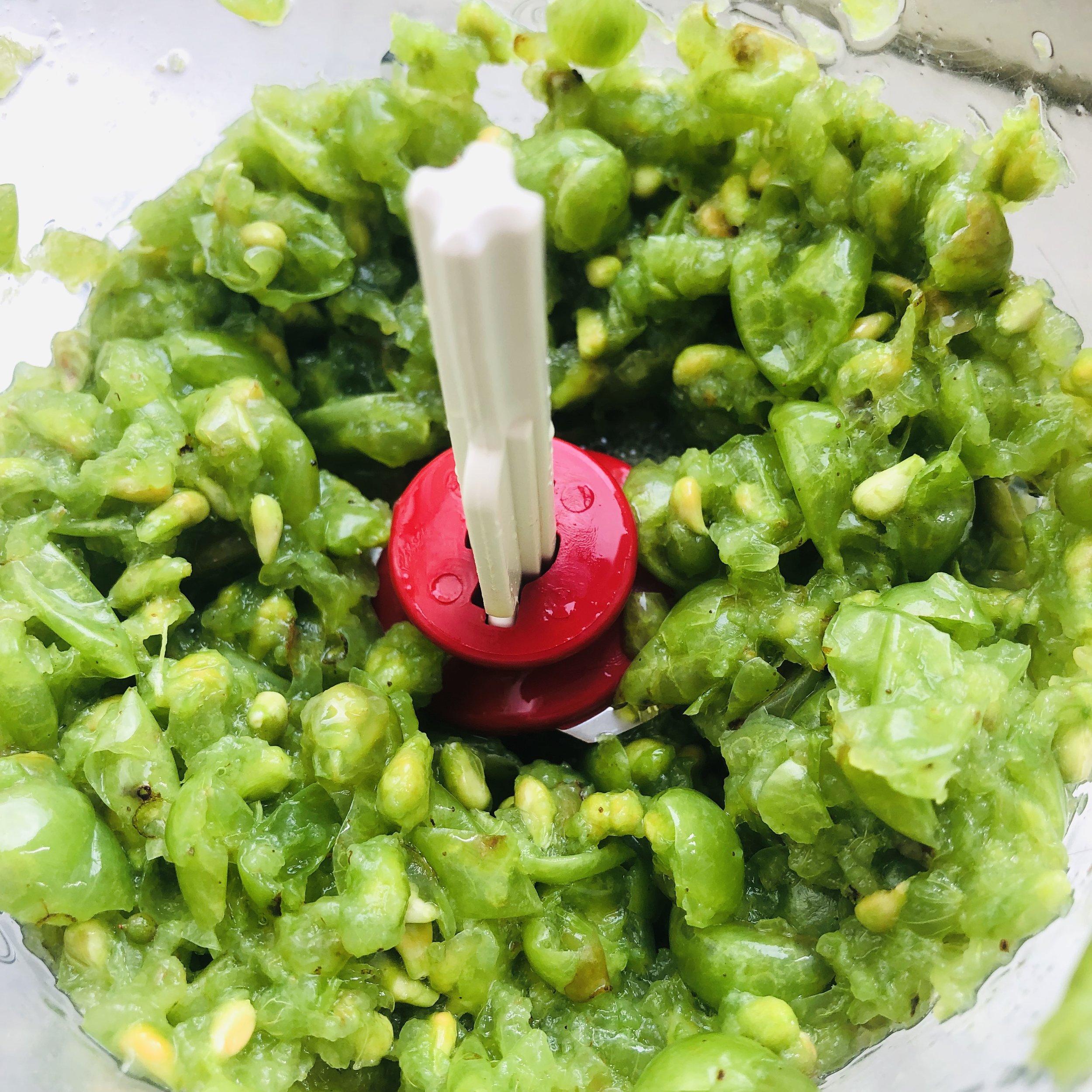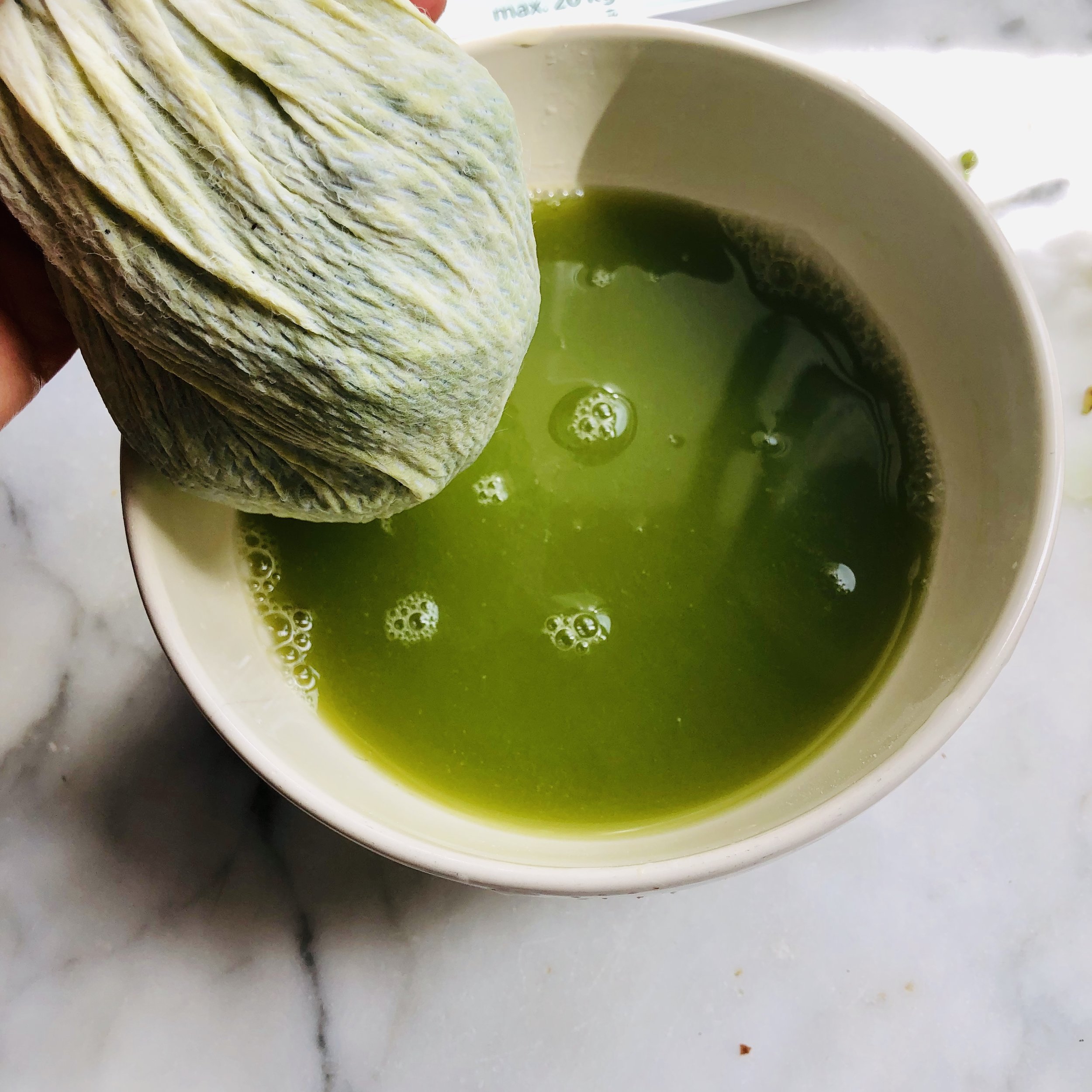Verjuice takes is name from the French verjus - green juice. It is a sour condiment made from the juice of unripe grapes that adds an acidic zing due to the presence of tartaric and malic acid. The Italian word agresto derives from Latin, directly referring to its sour quality rather than the color. Its use in Italy dates back to antiquity, but the stability and popularity of balsamic vinegar and widespread cultivation of the less perishable lemon, which began in the 15th century, would eventually make verjuice obsolete.
Platina, quoting the 5th century Roman provincial writer Macrobius, tells us that, “Vinegar is sharper than verjuice, whose force it is agreed is greater than acresta, which soothes the burning of the stomach more mildly, and does not weaken the body as vinegar is apt to do.” Cato recommends storing acresta in amphorae that should in turn be plunged into a fish pond to maintain the quality of the volatile contents. More poetically, Virgil speaks of the moon with the “verjuice blush of virgins” as a predictor of severe winds, “always in wind does Phoebe shine a golden red.” (Spoiler alert: check out version II below without ascorbic acid. That’s Phoebe Red. I got this.)
Picking green grapes for verjuice. Tacuinum Sanitatis (1474). Paris Bibliothèque nationale.
Agresto was so common that it came to be used as a metaphor for grumpy, rather like sourpuss - seen here in Florio’s 1611 Italian-English dictionary (recommended bedtime reading; the long S has a hypnotic effect, as your mind bobs between sibilants and fricatives):
It was a thing. On the heels of Florio’s scintillating dictionary came Giacomo Castelvetro’s The Fruits, Herbs, and Vegetables of Italy (1614), which tells us that “Every family with an acre of land makes at least one barrel of it,” every summer. Although I had skirted around recipes that included verjuice, as a culinary historian practitioner I could no longer avoid the fact that I was going to have to make it myself. I had to see for myself what the buzz was about.
There were other more elixir-like versions that mixed in spices, armagnac, vinegar, wine, must and/or salt, and cooked the juice, although not reducing it as much as the grape juice reduction called mosto (see mostaccioli). Interestingly, when I went on Amazon to see what was available commercially in Italy, I found this:
This product uses the calling card "balsamic" and is a combination of "mosto cotto" and grape vinegar. It is not unpleasant, even rather good, but in the end tastes like a sweet, mild balsamic vinegar, and misses the point that verjuice wants to make. (This is me talking - it looks like an advertisement, I know. Just me experimenting with formats).
So, what is it that makes pure verjuice unique? My personal assessment is that its edge lies in its tanginess. It is a subtle dimension that runs parallel to acidic and sour. It is far more volatile than its companions vinegar and lemon, but well worth the effort.
So! Let’s proceed, shall we?
Making verjuice at home:
The most time consuming part of this task is not squeezing and filtering, but pulling the tenacious grapes from the pedicel, which they hold onto for dear life. Be advised that some practitioners recommend wearing rubber gloves, due to the acidity. But if your hands are well seasoned from years in the kitchen, as mine are, you may only notice a slight itchy sensation after plucking and squeezing the grapes, which goes away by rinsing your hands under cold water to remove the acrid residue. (That was not the case when, gloveless, I de-seeded a kilo of green chilis to make a pickle and ended up agonizing in the ER with hands that felt like flame throwers). In order to have the proper level of acidity the grapes must be harvested before the sugar development is discernible. This will vary according to the varietal and your location. I used vernaccia grapes.
Procedure:
For about 800ml of verjuice, wash 1 kg of grapes. Pluck each grape from the pedicel. Put some music or a podcast on. You are going to be here a while.
Place the grapes in a food processor and add 1/2 tsp powdered ascorbic acid to temper oxidation, then pulse just enough to rupture the skins and cut through the fruit but not to disturb the integrity of the seeds, which would add an unwanted astringency.
Prepare a bowl with a sturdy piece of muslin or other filtering cloth that can accommodate a good quantity of pulp. Dump some of the pulp in, gather the cloth around it and squeeze, twisting a bit. The grapes will be very yielding. Squeeze until the dripping has stopped.
Here you have a couple options. You can either pour this juice into an ice cube tray to be used as needed, or you can filter it again and place in the refrigerator. It will slowly age this way.
sediment settling
second filtering
Grape enhanced photo - Anghiari
Verjuice: trial 2, table grapes
On August 18, I was invited to a friend’s house in the country in Anghiari. It was rather late in the year to be making verjuice, but I couldn’t refuse her generous offer of more grapes, curious to experiment with this very fragrant varietal, similar to concord grapes. These grapes pulled away from the pedicel easily, but were much more gelatinous inside which made expressing the juice more laborious. I had to wash the filtering cloth out between batches as it got pretty well gummed up. For this trial, I didn’t use ascorbic acid and it quickly oxidized (Phoebe effect).
The resulting juice was only slightly acidic, fragrant, and almost drinkable. I was concerned that the fruitiness might interfere with the results of the recipes, so I decided to set it aside and process it as vinegar, which I will surely put to good use, but cautiously in historical recipes.
Mother of vinegar
How exciting to be able to take a photo of the juice and her mother, formed after just 10 days! Both are doing fine.
Let’s get cooking.
Cristoforo Messisbugo, a nobleman who worked as a steward/purveyor, or proveditore, in the d’Este household in Ferrara, and lent his services to the Gonzaga court, leaves us this recipe for fried mushrooms in Banchetti (1549). The combination of a fried food, rendered delicately pungent with verjuice, can be likened conceptually to an escabeche. If you don’t have verjuice, a light wine vinegar or a conservative squeeze of fresh lemon juice will do in a pinch.
Fried mushrooms with verjuice
Ingredients:
100 g flour (type 0)
400 g portobello mushrooms
oil for frying
2 cloves garlic, finely minced
1 bunch parsley, finely minced
2 tbsp olive oil
100 ml verjus
salt and pepper
Instructions:
Wash the mushrooms and cut into slices.
Keep them dampish and dredge in flour.
Leave them sit a while to absorb the flour.
Heat 3cm oil in a frying pan.
Fry the mushrooms until golden brown and drain on paper towels. Press them a bit to remove excess oil.
Heat the olive oil and lightly sauté the garlic.
Add the mushrooms and parsley and toss.
Heat them well and sprinkle with verjus, salt and pepper off heat. Toss.
The mushrooms can be fried ahead and then tossed last minute.

















